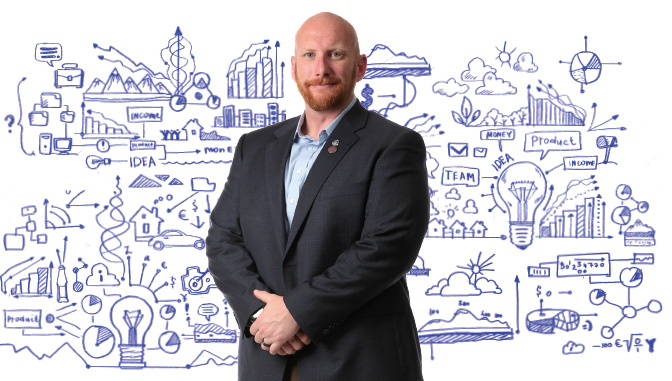Project Management 101

ALUMNUS KANE TOMLIN PRESENTS WEBINAR SERIES
One only needs to search “project management” to see the rapid and growing influence of this business practice in today’s global market. Based on independent research, the Project Management Institute (PMI), which offers eight certifications that recognize knowledge and competency, asserts that the project management-oriented labor force is expected to grow by 33 percent—nearly 22 million new jobs—by 2027.
According to Kane Tomlin, ’12, ’14, that’s good news. Tomlin is a PMI-certified Project Management Professional who oversees the project management office of the Florida Department of Law Enforcement where he works as a special programs administrator. He studied criminal justice and cybersecurity at Excelsior and now serves on the College’s Alumni Leadership Council. Through his work on the Council, he recently launched a quarterly alumni speaker series on project management to help his fellow alumni and current students make sense of one of the fastest-growing fields.
“Project management is as simple or as complicated as the project,” says Tomlin. “And the skill set starts with being intellectually curious,” he says, adding that PMI thinks of project management as more than a skill; it considers it to be a profession. Skill, profession, or both, project management, Tomlin explains, is a cognitive process that leads to the most effective and efficient way to perform the work. From this perspective, it’s easy to see why employers are interested in having project managers on board: how effectively you execute the growth strategy of the organization is directly related to success markers such as profit.
While many of us who are not project managers may feel as though we do this type of work in our jobs every day, not all projects are created equal. Within the industry, projects are clearly defined by the following criteria: 1) a specific product or service, 2) with a start and end date, 3) that has never been done before by you or your company, 4) which requires planning and execution, and 5) has unknown variables.
Or, as Tomlin describes it, a project is any one-time effort with an end-state goal. It can be as simple as making a pot of coffee (if you’ve never made one before) or as complex as building a stadium or IT system. However, all projects share the same three constraints: limited budget, limited time, and performance constraints (good and fast vs. fast and cheap vs. good and cheap).
So, what does it take to be one of these in-demand project managers?
If you like working in an area where there isn’t much information provided, and that requires you to do research in order to accomplish your goals, then you will enjoy project management. Project managers possess the following skills and attributes: problem solver, positive attitude, high-level communication ablities (written and verbal), systematic mindset (breaks down problems), enjoy challenges, enjoy a lack of routine, and highly goal-oriented.
Project managers follow a prescribed process for handling the work. Remember those three constraints that affect every project? Project management begins with identifying the driver constraint (least flexible) and weak constraint (slightly negotiable) related to the project at hand. Then, it involves breaking down the work into a method that can be organized into a project schedule. For example:
STEP 1: Make a list of every task that needs to be done in order to complete the project.
STEP 2: Interview subject matter experts to find out what steps they need to take to complete their portion of the project (for example, if you’re building a stadium, the subject matter experts would include the architect and general contractor).
STEP 3: Determine task dependencies, such as tasks that can be completed simultaneously and those that need to be completed before another task can be started.
STEP 4: Schedule the work; how long each task will take is often identified through those interviews and conversations with the subject matter experts in Step 2.
Scheduling the work isn’t the end of the planning, of course. Some tasks take longer than scheduled and project managers have to compensate by shuffling people, time, and money to meet goals. That’s where, Tomlin says, the most important quality of project managers comes into play: problem-solving.
“The reason is twofold. First, the simple act of starting a project usually involves some version of ‘how do we solve this problem or overcome this challenge,’” says Tomlin. “Second, once the project is underway, no matter how much planning you have done, new problems will arise.” — by Renee Kelly


